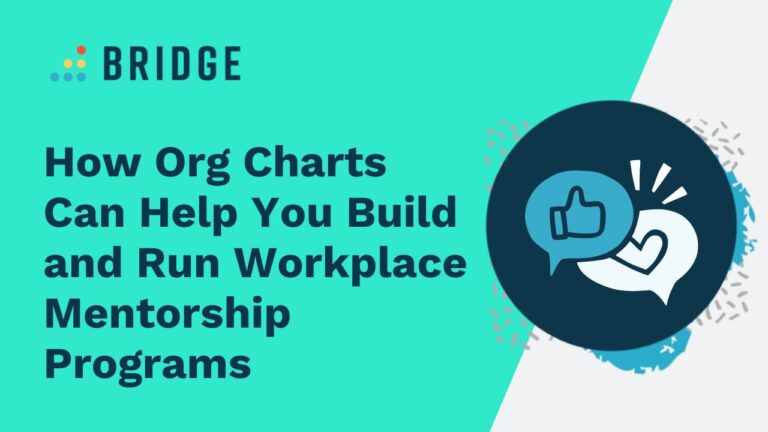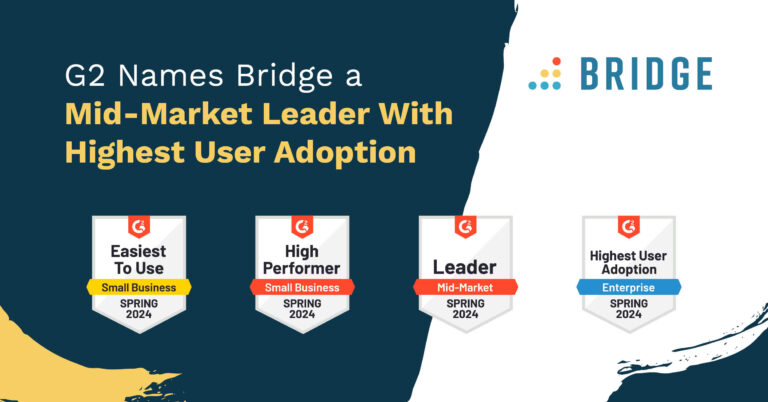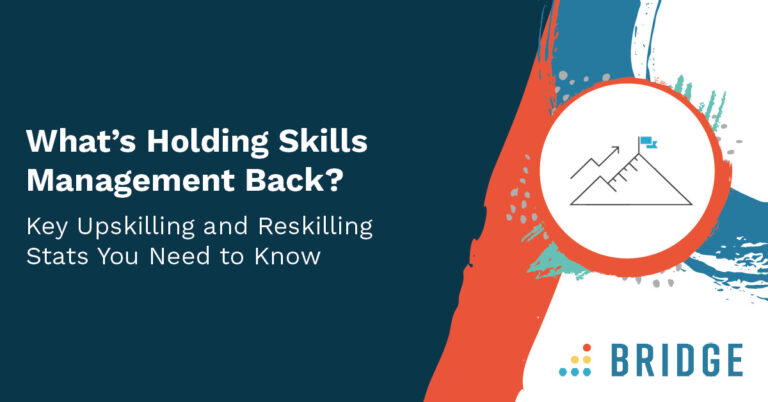In a professional context, we all expect to learn from the people around us—absorbing the knowledge of our peers and managers by observing how they work and following the instructions they give. To realize the full employee performance benefits of your workforce’s wisdom, however, you need to add purpose and structure to these ad hoc learning opportunities.
That’s where mentorship comes in.
By formalizing your peer- and manager-based knowledge sharing through a mentorship program, you’ll ensure that your employees are able to develop relevant skills and grow in the right directions as directed by the most qualified individuals available.
Strong mentorship programs require planning, and they’re built on knowing where your employees’ expertise can be found. That’s why we’ve put together some handy guidance on how to make the most of your mentors, and how org charts can elevate the programs you put in place.
What Is a Mentorship Program?
We’ve all experienced mentorship at one time or another, whether as a mentor or as a mentee. Mentorship is all about guiding, advising, teaching, or helping a less experienced person in either an educational or a professional context.
A good mentorship program adds a touch of procedure to mentor-mentee relationships by:
- Providing the tools to locate mentors
- Showcasing mentor skills and availability
- Displaying employee skill development aspirations
- Advising mentors and mentees on practical considerations like meeting scheduling
An advanced mentorship program might also provide rules or guidelines covering how long a mentoring relationship should last, the format that mentoring sessions can take, and the number of people involved in a given mentoring session.
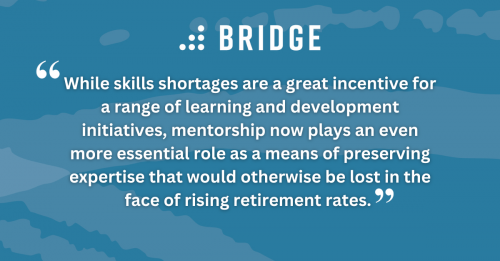
5 Reasons Mentorship Matters for New and Existing Employees
Skills gaps are a real and growing problem, impacting everything from individual business success to large-scale economic productivity. They’re neither uncommon nor US-specific—in fact, according to a UK study, four out of five small and medium businesses report a skills gap in their workforces.
Though the global skills gap has been caused by a variety of factors, it’s hard to ignore the role played by retirement. A report from the Administration on Aging has found that 17% of Americans were over 65 in 2020, and that figure is projected to rise to 22% by 2040. These figures are a firm reminder that many organizations will inevitably lose their most experienced workers in the coming years—along with the vital skills and knowledge they represent.
As such, while skills shortages are a great incentive for a range of learning and development initiatives, mentorship now plays an even more essential role as a means of preserving expertise that would otherwise be lost in the face of rising retirement rates.
This may be a compelling case for placing an emphasis on mentorship, however it’s far from the only one! That’s why we’ve put together a selection of five further advantages:
1) Mentoring New Employees Can Improve Onboarding
Though mentoring is often associated with advanced training that hones specific skills for future roles, your mentoring program could be adapted for use as part of your onboarding process by pairing new starters with a general mentor figure. Rather than offering role-specific training, an onboarding mentor can ease the transition for new hires by offering insights into company policies, procedures, and practices in a friendly and personal way.
Mentorship is all about sharing knowledge that more inexperienced colleagues don’t have, and for new starters, that can cover everything from role-specific functions to office fridge etiquette!
The benefits of a good onboarding experience speak for themselves, especially when it comes to reducing that all-important time to proficiency. Plus, as one study notes, a mentor can make all the difference in the context of remote work, which can involve potentially confusing protocols or reduced opportunities for meeting colleagues.
KEEP READING | ‘5 Ways to Achieve Better Employee Onboarding With Bridge Journeys’
2) Good Mentors Improve the Learning Experience
Onboarding is only needed once—but the skill development that your mentors foster is an ongoing process that every employee will benefit from. We’re big advocates for L&D programs packed with expertly authored training content, but your learners will always benefit from the additional input of mentors whose years of experience have left them well-versed in the tricks of the trade.
These benefits have been spelled out in an academic study on mentorship in an educational context. The authors found that mentorship can improve learners’ confidence, help them to gain new competencies, and improve their critical thinking—and there’s no question that these advantages are equally felt in the world of professional development.
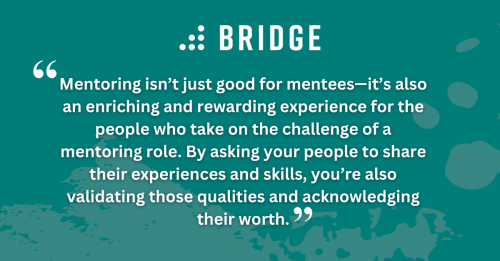
3) Your Mentors Share and Represent Your Company Culture
Skills development is the primary goal of any mentorship program—but a good mentor will also reflect, represent, and actively offer a little guidance on your company culture more broadly.
The value of mentors in this sense is particularly significant now that many organizations are adopting an approach that distributes responsibility for developing a good culture among all employees. Placing experienced individuals in mentor roles is a fantastic way to help reinforce your ideal culture—rather than leaving it all up to senior leadership teams or HR departments alone.
4) Human Connections Foster Wellbeing
While a mentor-mentee relationship is a professional connection, there’s inevitably a social component to each interaction. As such, mentorship can form the foundation of friendship, trust, and mutual respect between employees who might not have had the opportunity to meet under normal circumstances (especially in a displaced workforce).
Clearly, mentorship strengthens the ties that bind your people together and provides a wealth of opportunities for new relationships to form. According to the Chartered Institute of Personnel and Development (CIPD), social connections represent one of seven key domains for workplace wellbeing. The CIPD points to healthy peer and manager relationships as a key part of this domain, and mentorship is one among the many forms that supportive workplace connections can take.
MORE ABOUT WELLBEING | ‘8 Ways to Create & Promote Psychological Safety in the Workplace’
5) You’re Demonstrating the Value of Your Mentors’ Skills
Mentoring isn’t just good for mentees—it’s also an enriching and rewarding experience for the people who take on the challenge of a mentoring role. By asking your people to share their experiences and skills, you’re also validating those qualities and acknowledging their worth.
Deloitte research has found that 84% of people want to be provided with meaningful work. No matter what your organization or industry involves, mentoring is the perfect way to add meaning to any experienced employee’s working life, creating a truly win-win scenario for everyone involved.
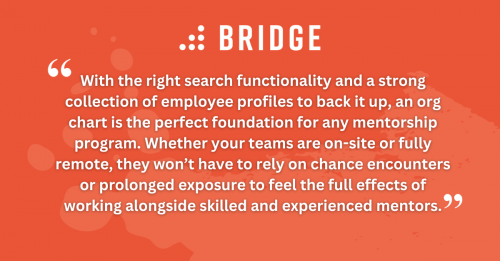
Taking Your Mentorships to the Next Level With an Org Chart
Clearly, mentorship offers a wealth of benefits—but they’ll only be felt if your mentees can actually find a mentor in the first place! Your mentors need to broadcast their skills, availability, and willingness to drop a few pearls of wisdom, while your mentees need a way to search for mentors who have the skills they’re looking to develop.
As luck would have it, both of these challenges can be overcome in one single, simple gesture with the help of an org chart.
What Is an Org Chart?
An org chart maps out the structure of your company and the relationships between different individuals, teams, and departments.
The best org charts will also house profiles for each of your people. These profiles will include names, departments, job titles, one or two personal tidbits, and—crucially—the skills that each employee is prepared to offer mentorship in.
Just as importantly, a good org chart will include a search function allowing employees to find specific people—and for would-be mentees to find the skills they need from mentors within your workforce.
How an Org Chart Can Boost Your Mentoring Programs
By using your org chart’s search function to seek out a specific skill, your people will have instant visibility into every colleague who’s expressed an interest in helping to develop that skill. Equally, your mentors will have no trouble finding employees who want to take advantage of their expertise.
This process isn’t just about locating individuals, but entire skills communities that allow groups of colleagues to work together to teach, learn, and grow cooperatively.
With the right search functionality and a strong collection of employee profiles to back it up, an org chart is the perfect foundation for any mentorship program. Whether your teams are on-site or fully remote, they won’t have to rely on chance encounters or prolonged exposure to feel the full effects of working alongside skilled and experienced mentors.
FUEL EMPLOYEE SUCCESS | ‘4 Steps to Create an Employee Development Plan’
Create Mentorship Opportunities With Bridge
Inside Bridge, each employee can have their own profile personalized with their bio, image, and skills. Individuals can highlight the skills they have—and are willing to share—and identify skills that they want to learn. Share employee profiles in an interactive org chart and directory and employees can learn about their colleagues both personally and professionally.
If you want to learn more, contact us today!
